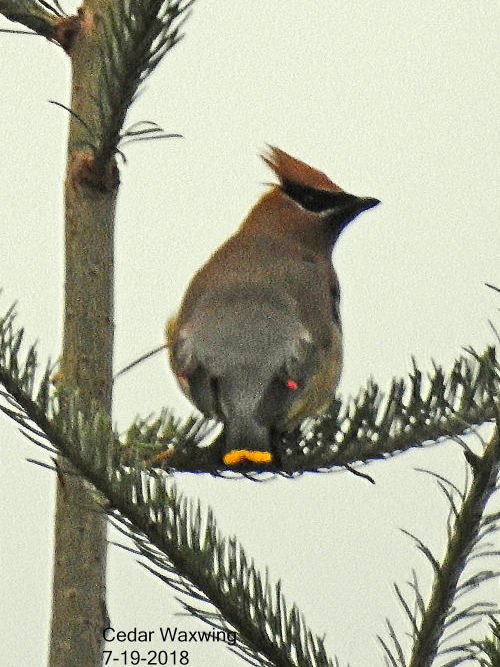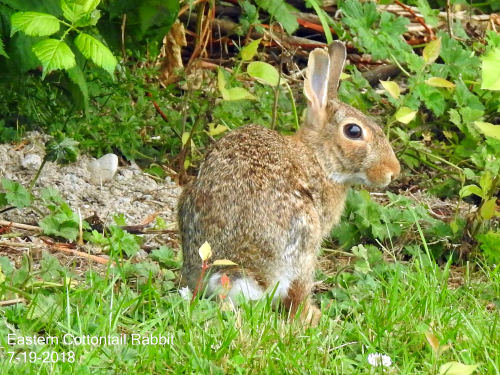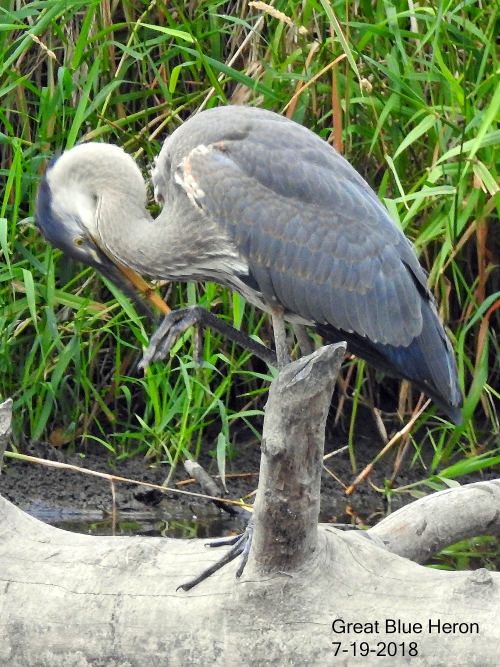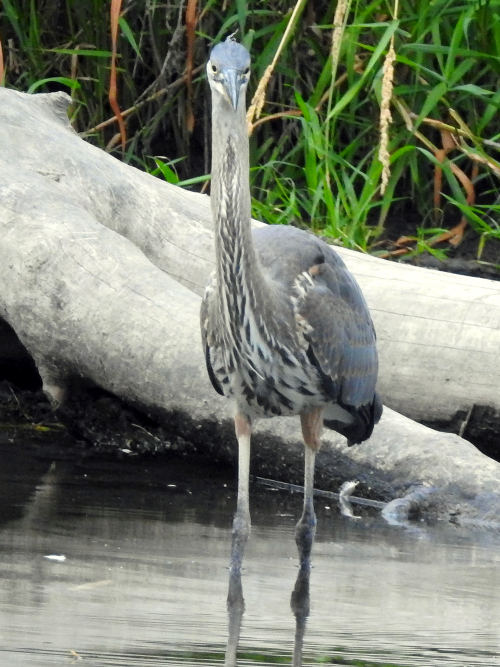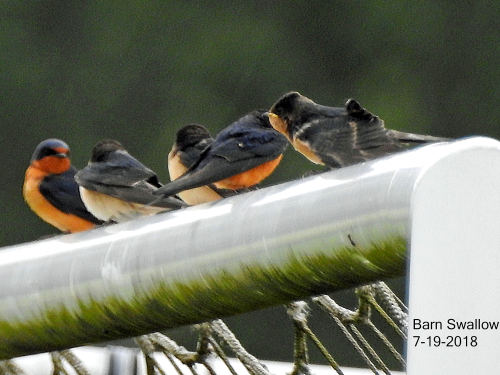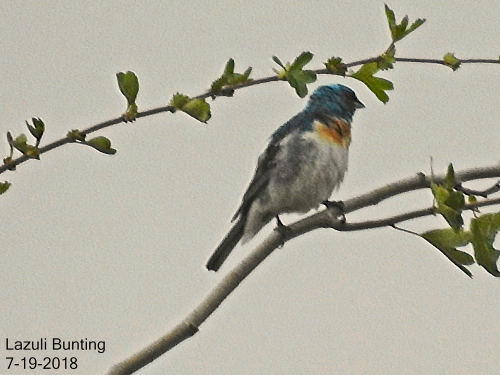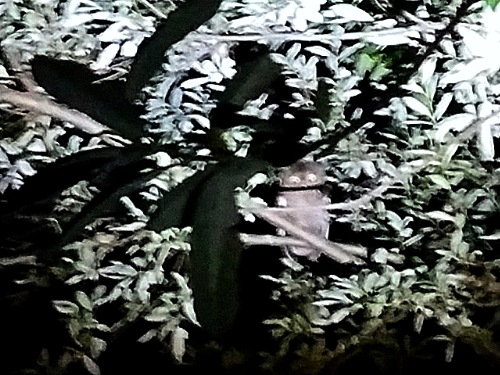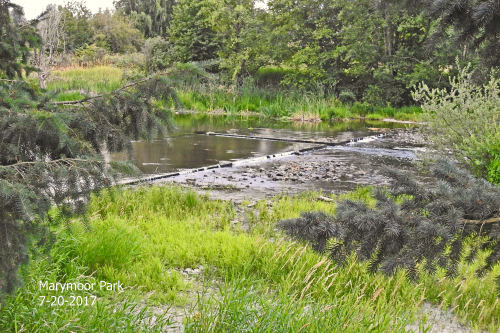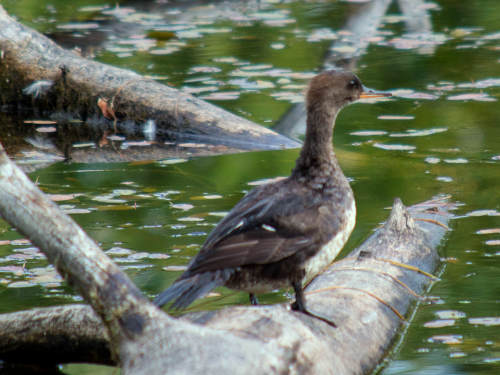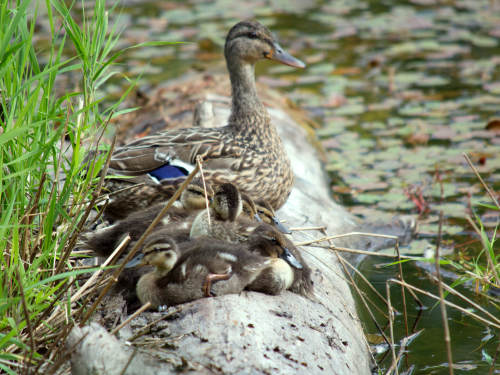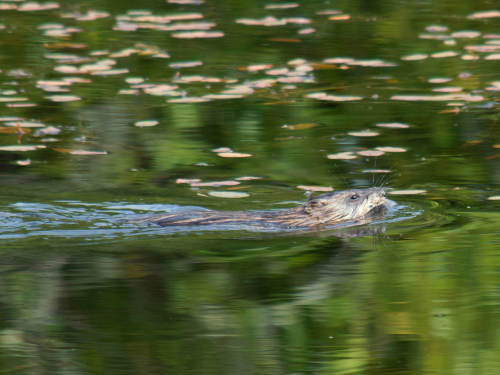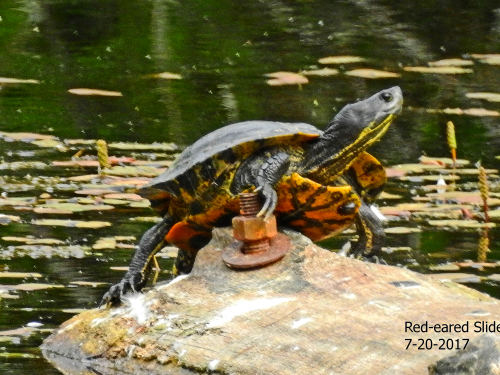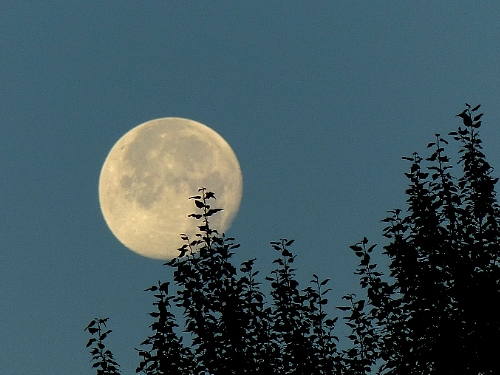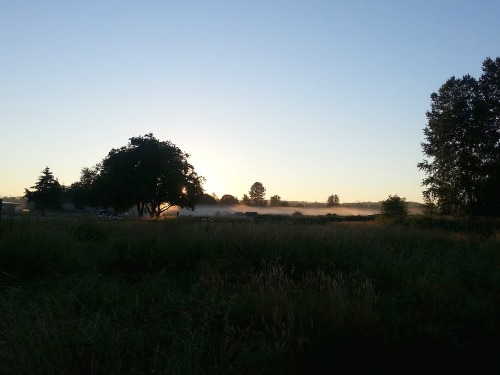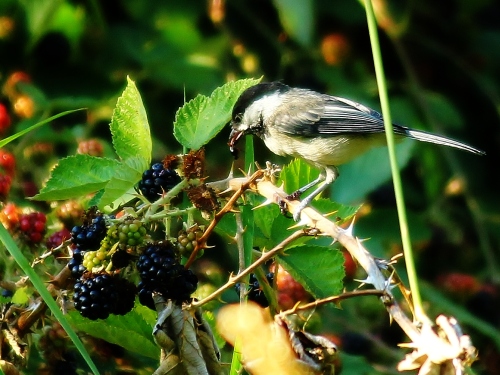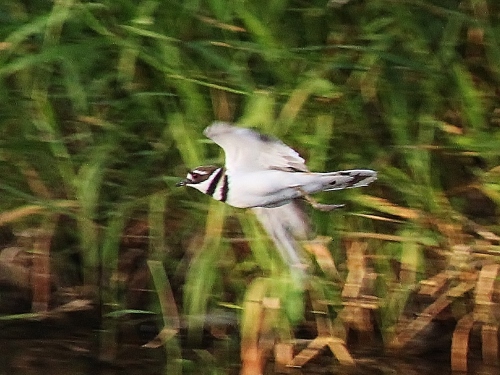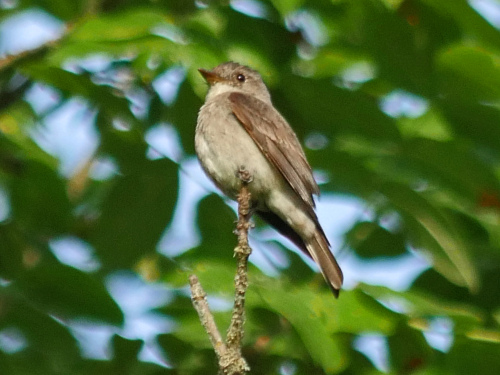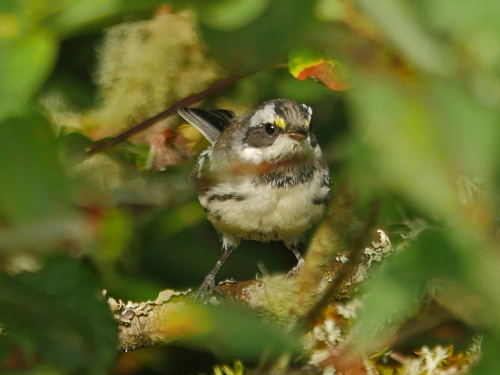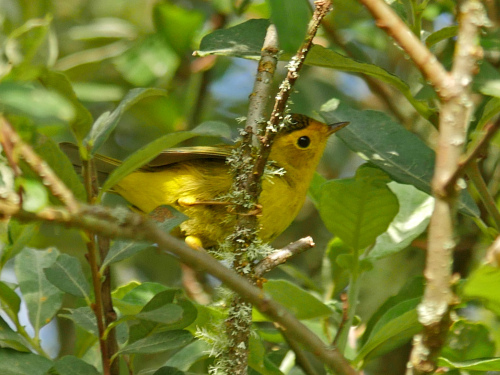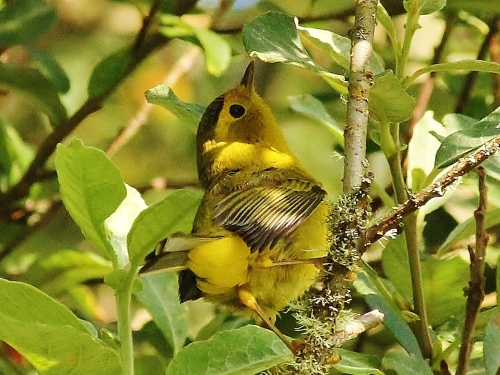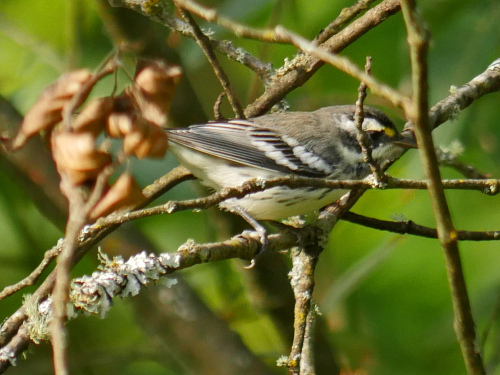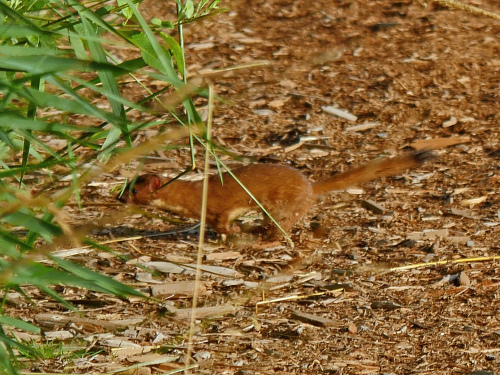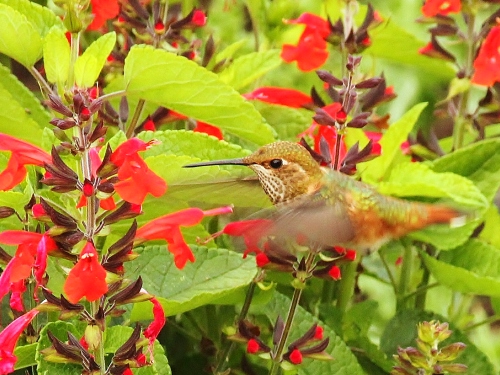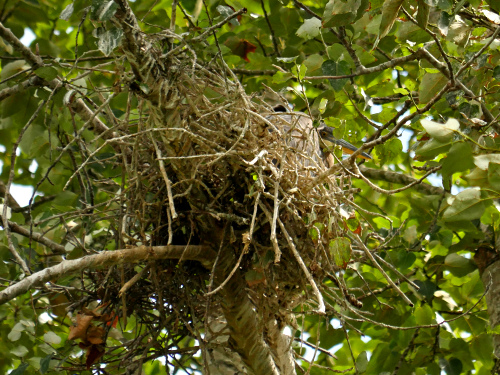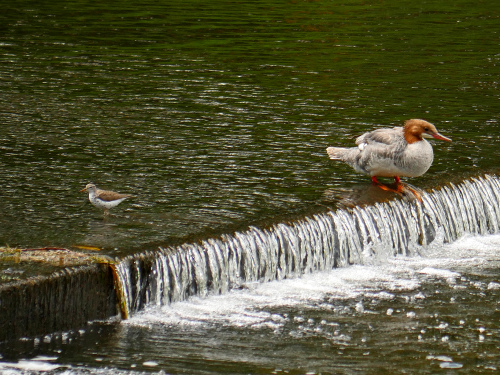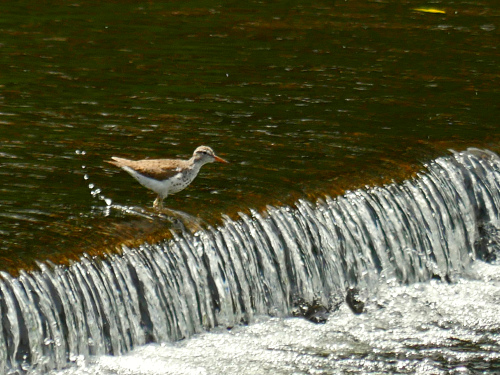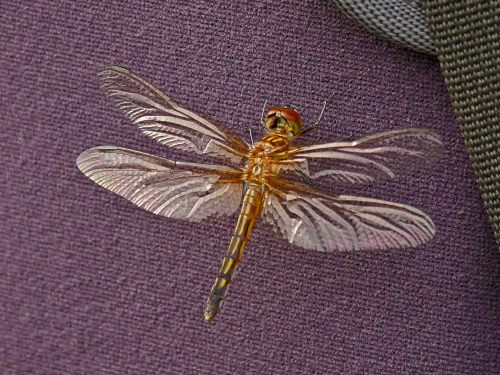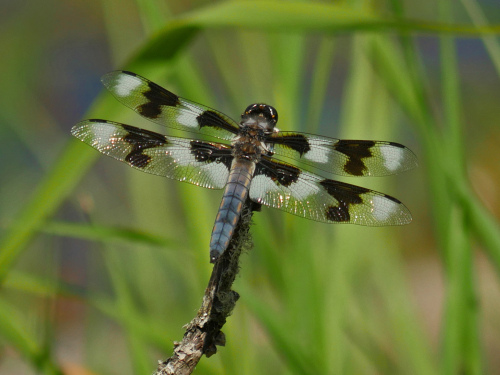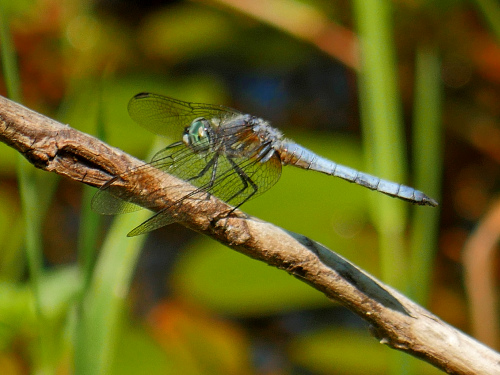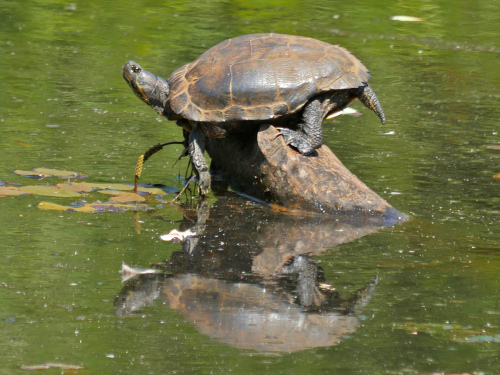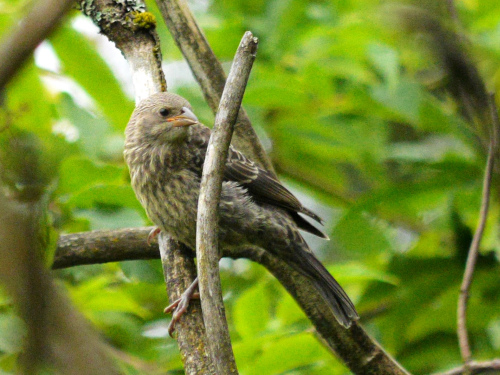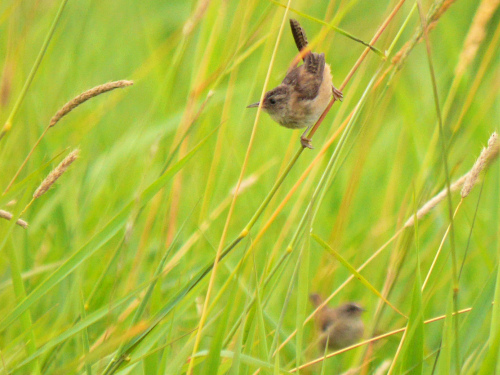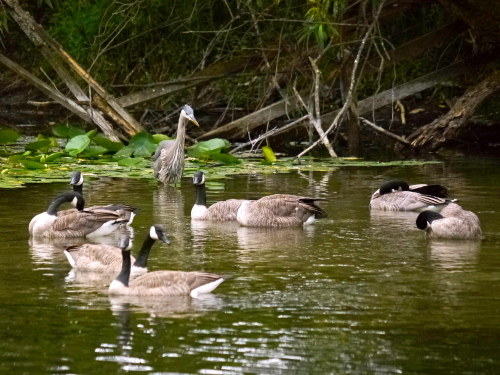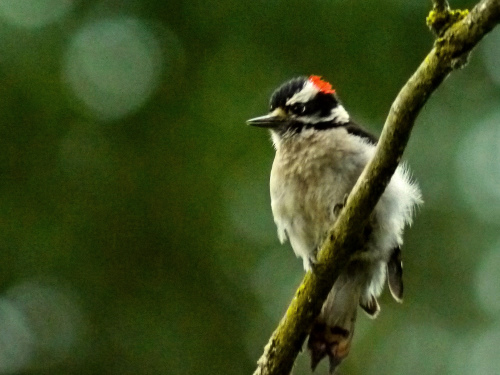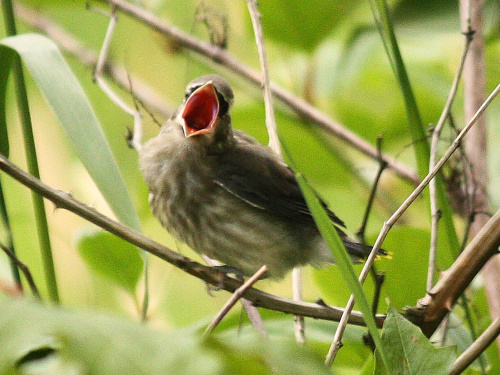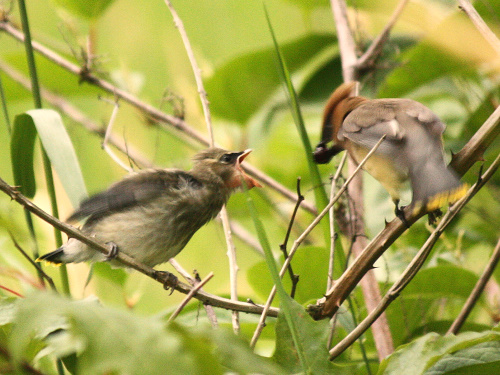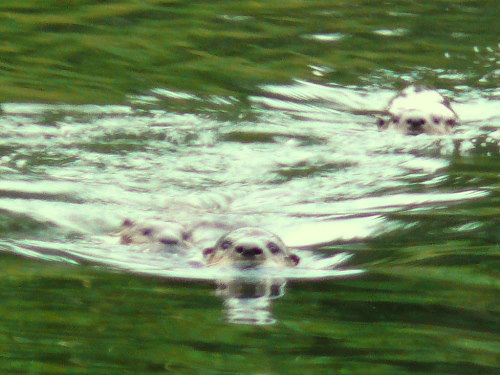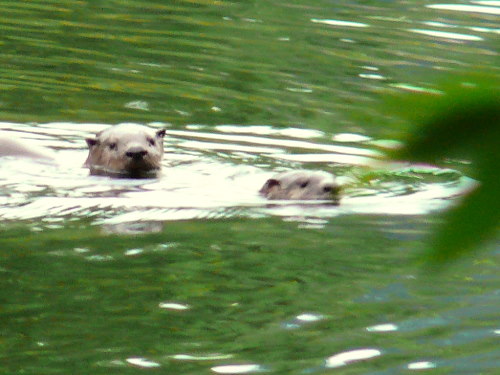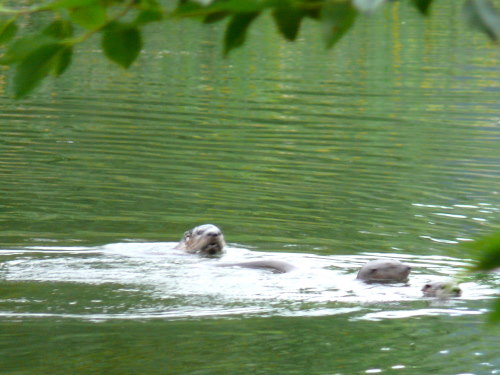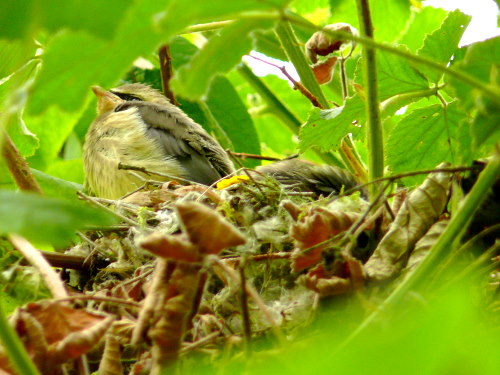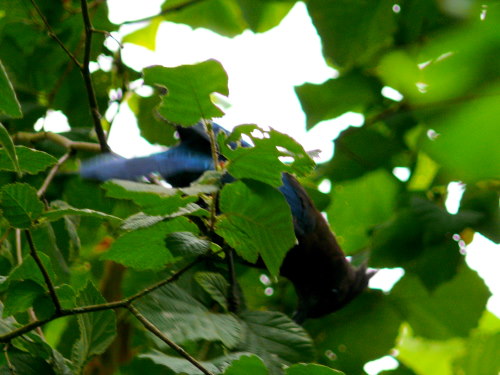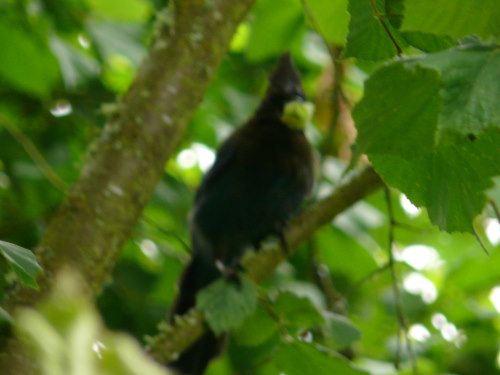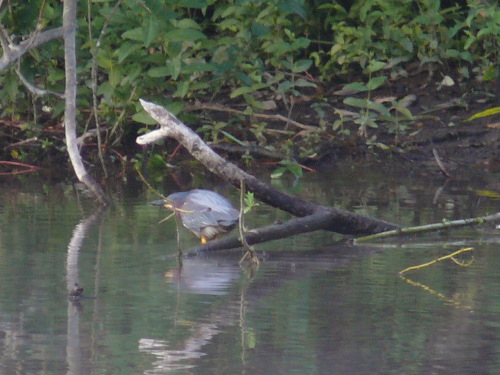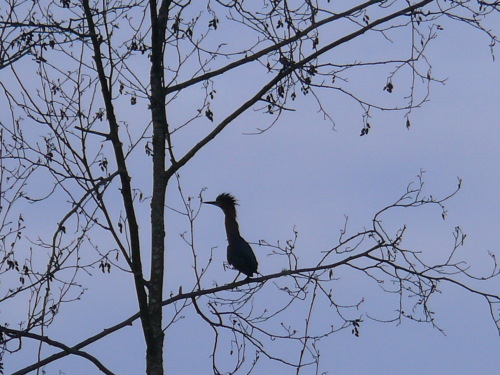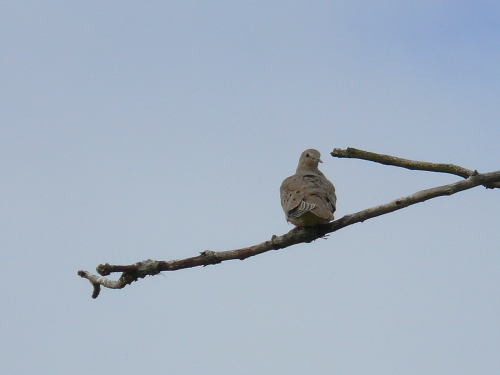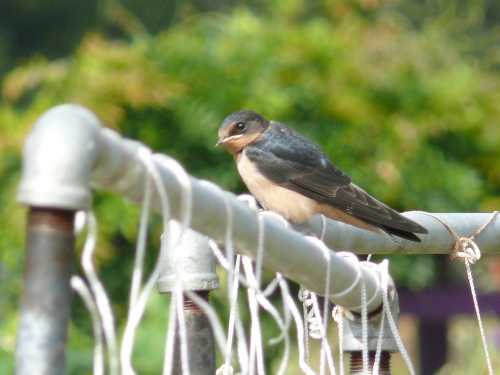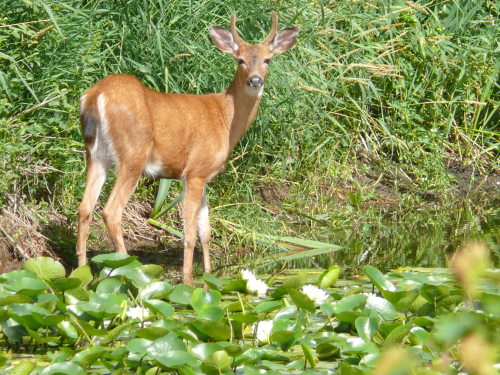Prev |
Bird Sightings Week 29
|
Next |
Rarities for Week 29:
| Redhead | 18-Jul-02 | With mallards at lake platform |
| ...Least Flycatcher | 19-Jul-07 | On territory near Dog Central, 17-Jun through 15-Jul |
| ...Indigo Bunting | 09-Jul-20 | Singing male, Dog Meadow, 11-Jun to at least 16-Jul |
Report for July 17, 2025 Birding at Marymoor
| We had a very fine morning, with temperatures never getting too warm despite the full sun and the Excessive Heat Warnings. And while singing has become almost non-existent (except for Swainson's Thrushes), there were plenty of birds around. We are seeing strong evidence of post-breeding dispersal, with many birds today that we haven't had in weeks or months. Highlights:
For the day, counting the high-flying gulls, 61 species. A good day. = Michael Hobbs |
Report for July 18, 2024 Birding at Marymoor
| Another sunny, warm morning with clear blue skies. Less singing than last week, perhaps. Highlights:
For the day, 57 species = Michael Hobbs |
|
|
|
|
|
|
|
Report for July 20, 2023 Birding at Marymoor
| It was a nice a day as possible at Marymoor today: temps in the 60's - 70's, clear blue sky, hint of breeze. Breeding season is wrapping up, and we saw the first signs of post-breeding dispersal; we saw a few species that don't actually breed in the park. Total number of birds was actually not that high, possibly since some of our breeders are off on their own post-breeding dispersal. Highlights:
Even with those misses, we had 58 species today plus "dark wing-tipped gull". We also had beaver and a deer. = Michael Hobbs |
Report for July 21, 2022 Birding at Marymoor
| Another gorgeous summer day, with temps running from 60-70 degrees, and few clouds. Fairly birdy. We're just beginning to get the start of post-breeding dispersal, so we had a few birds we haven't seen in a while.
Highlights:
Our mammal list included American Beaver, Raccoon, and Bat. We failed to see a squirrel.
Misses today included Hooded Merganser, Rock Pigeon, Rufous Hummingbird, Red-tailed Hawk, Barn Owl, Cliff Swallow, and Black-headed Grosbeak.
For the day, 60 species.
= Michael Hobbs
|
Report for July 19, 2018 Birding at Marymoor
| Cooler temps, and a gloomy overcast that threatened rain, added to the end-of-breeding-season quiet, making birding somewhat uneventful and QUIET today.
We’re definitely seeing shifts in bird populations, such as large flocks of European Starlings and House Finches, and a large drop in the numbers of Great Blue Herons. In general, we found fewer birds, less singing, and few good views today. Many species were only glimpsed, with some just barely heard. Swainson’s Thrush and Willow Flycatcher were both present in pretty good numbers still, but both were doing more whits than songs, and neither species was seen. Highlights:
Critters seen included dozens of Eastern Cottontails, Matt had a Mule Deer, and a few of us spotted a LONG-TAILED WEASEL at the north end of the East Meadow. Misses today included Rock Pigeon, Green Heron, Warbling Vireo, Cliff Swallow, and Marsh Wren. For the day, 61 species. Bank Swallow was new for 2018 for us, but has been previously reported on eBird this year. == Michael Hobbs |
|
|
|
|
|
|
|
Report for July 20, 2017 Birding at Marymoor
| Mostly cloudy and a bit breezy, and QUIET. We’re pretty much into the post-breeding lull; birds have left the park, and not much has moved in. Really noticeable change from last week, though some of what we missed today might just have been that we missed them.
Highlights:
Brian and I found the WESTERN SCREECH-OWL at 4:30 a.m.in precisely one of the places adult Screech were frequently seen this spring (near the old “willow” interpretive sign). It was fledged, but still in juvenile plumage, very similar to this photo from Paws: At the Lake Platform, we stood around for AT LEAST 10 minutes, with no sign of any PURPLE MARTINS. Then, just as we were about to leave, two emerged from the gourd(s), surprising us all. The really notable thing today was all of the species we didn’t find, or where the numbers were WAY down from last week. We had only a single WESTERN WOOD-PEWEE, and that was heard-only. Misses included Chestnut-backed Chickadee, Red-breasted Nuthatch, Purple Finch (might have heard one), Yellow Warbler and Yellow-rumped Warbler (or indeed any warbler besides Common Yellowthroat), Black-headed Grosbeak !!!, Lazuli Bunting, and Brown-headed Cowbird. On the mammal front, Brian and I had myotis sp. bats from the boardwalk. For the day, just 54 species. == Michael Hobbs |
|
|
|
|
|
|
|
Report for July 21, 2016 Birding at Marymoor
| A glorious day today, with perfect temperatures, sunshine, and BIRDS. Lots of babies, lots to be seen.
Highlights: Wood Duck Two clutches of ducklings At the Rowing Club, we had 2 adult GREEN HERONS at the pond, and between the pond and the row house, we had a large family flock of BUSHTITS. The baby bushtits crammed all along one branch in a chain of at least 10 babies, all touching. Parents were coming in and feeding. Even Matt said we could call them “cute”. Non-birds included pre-dawn COYOTE, lots of bunnies, one AMERICAN BEAVER, and a good number of GARTER SNAKES. 8-spotted skimmer dragonflies were all around and over the Rowing Club ponds and the slough. Misses for the day included Pied-billed Grebe, Rock Pigeon, Yellow Warbler, and Red-winged Blackbird. Even so, we managed to find 64 species. Adding GREATER YELLOWLEGS and CASPIAN TERN gets us to 136 species for the year, I believe. == Michael Hobbs |
|
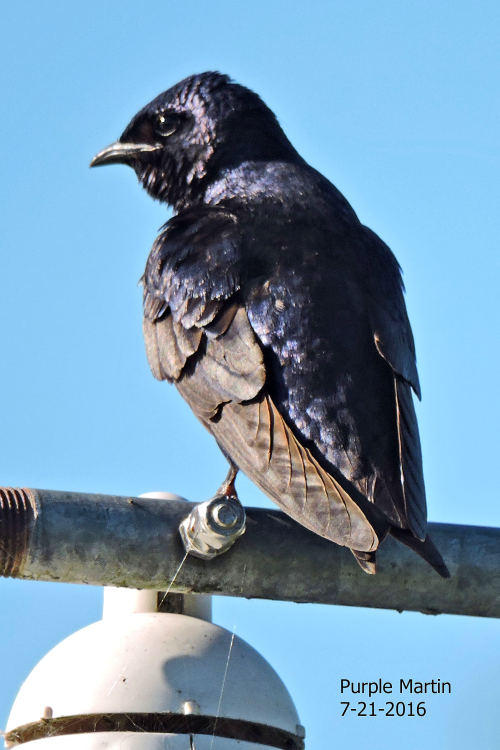 Male Purple Martin. Photo by Bob Asanoma |
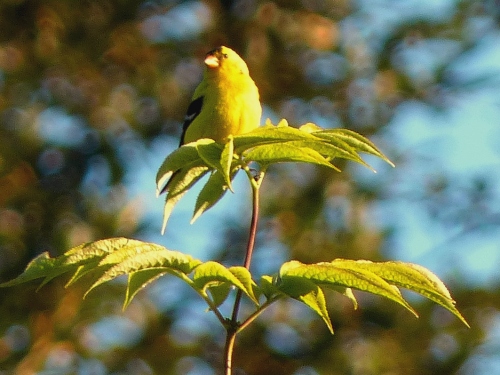 Male American Goldfinch. Photo by Hugh Jennings |
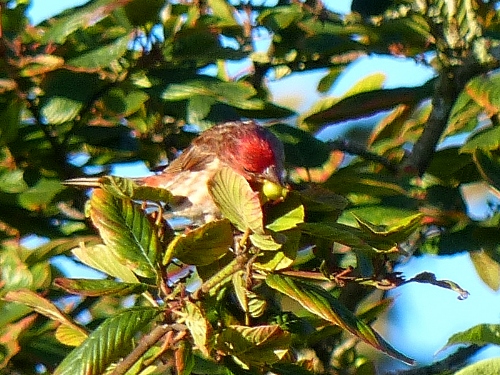 Male House Finch. Photo by Hugh Jennings |
|
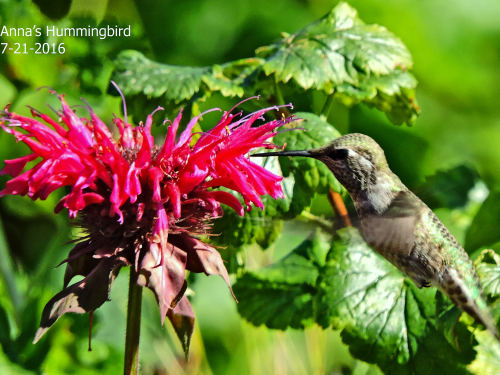 Anna's Hummingbird. Photo by Bob Asanoma |
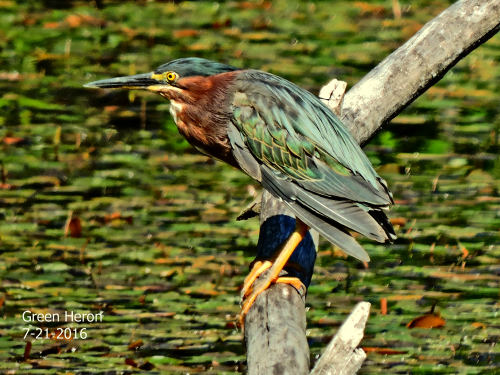 Adult Green Heron. Photo by Bob Asanoma |
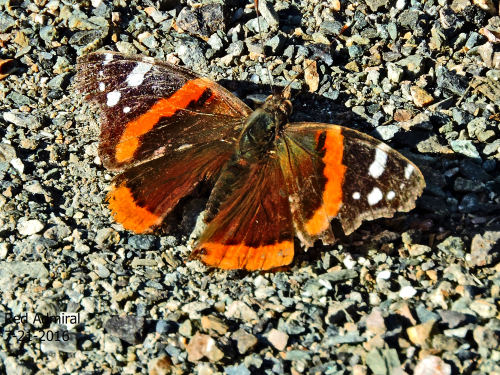 Red Admiral butterfly. Photo by Bob Asanoma |
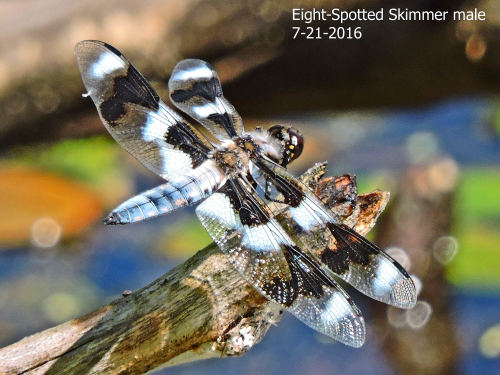 Male Eight-spotted Skimmer. Photo by Bob Asanoma |
Report for July 16, 2015 Birding at Marymoor
| It was a pleasant morning to walk around today, as the overcast kept the temperatures down in the ‘60’s. No bright glare either. We are officially in The Summer Doldrums, but even the doldrums are good at Marymoor.
Highlights: Canada Goose Actually saw one this week :) I also saw a MINK on the far shore of the slough, a bit above the weir. For the week, 59 species. == Michael Hobbs |
|
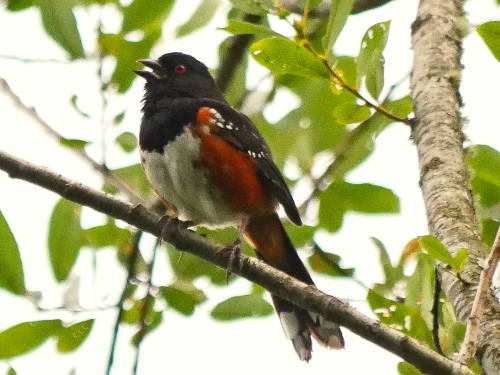 Singing male Spotted Towhee. Photo by Ollie Oliver |
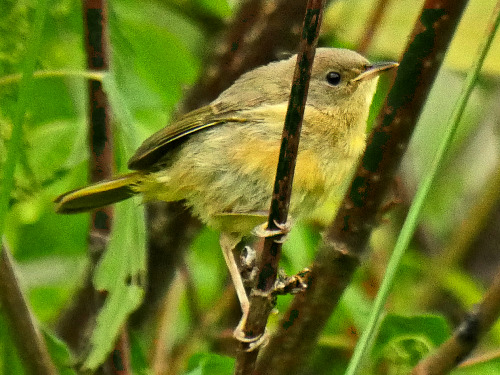 Juvenile Common Yellowthroat. Photo by Ollie Oliver |
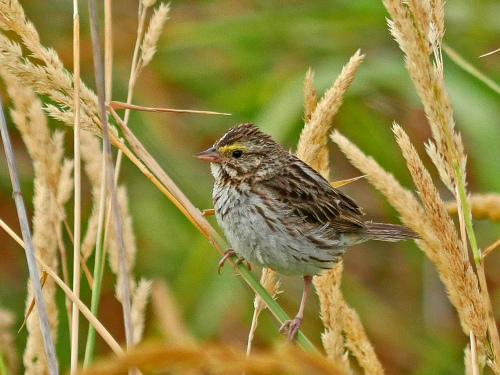 Savannah Sparrow. Photo by Ollie Oliver |
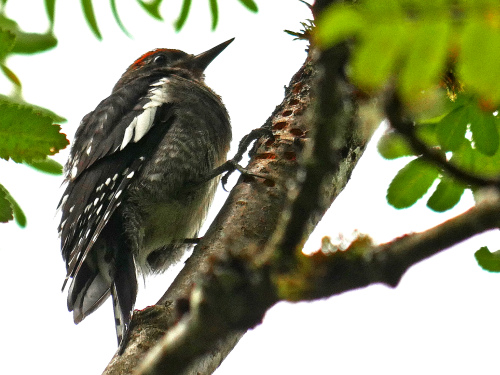 Juvenile Red-breasted Sapsucker. Photo by Ollie Oliver |
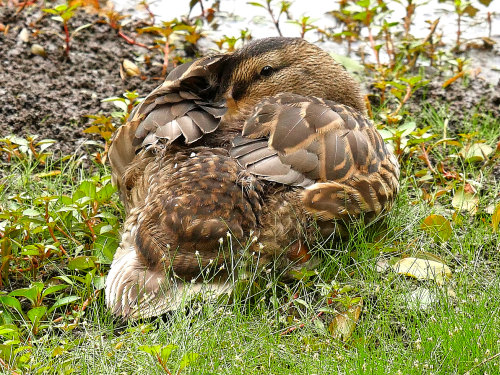 Mallard. Photo by Ollie Oliver |
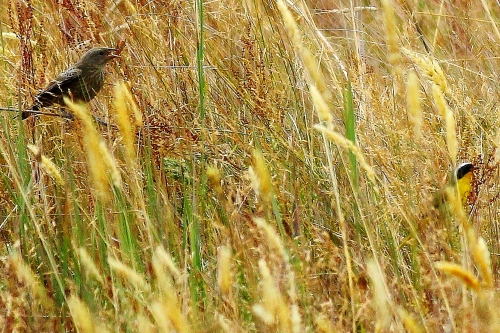 Male Common Yellowthroat being followed by a juvenile Brown-headed Cowbird. Photo by Lillian Reis |
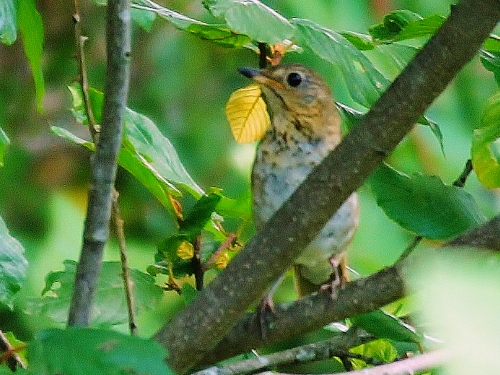 Swainson's Thrush. Photo by Lillian Reis |
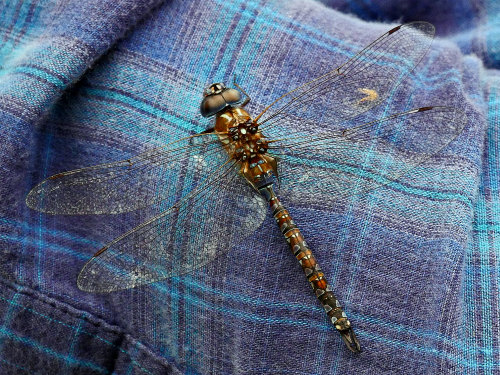 Dragonfly. Photo by Ollie Oliver |
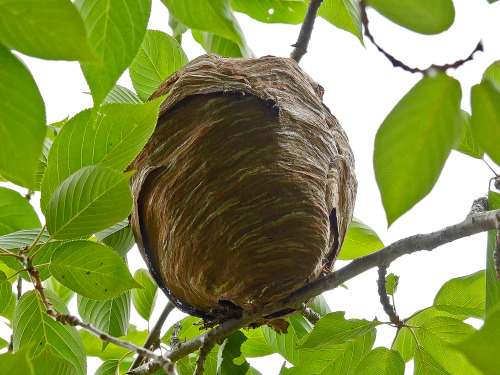 Bald-faced Hornet nest. Photo by Ollie Oliver |
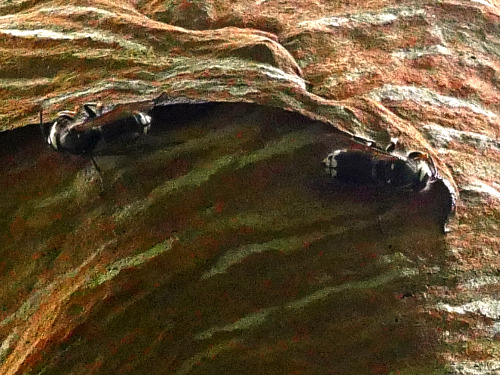 Bald-faced Hornet nest. Photo by Ollie Oliver |
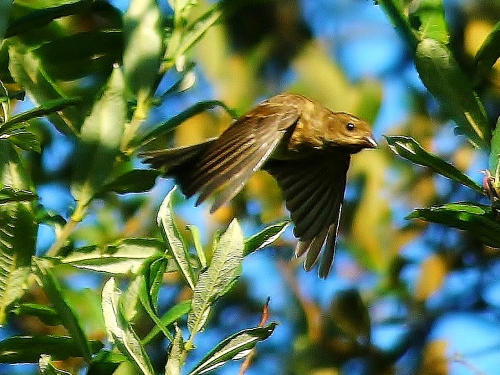 Finch in flight, 2015-07-14. Photo by Lillian Ries |
|
Report for July 17, 2014 Birding at Marymoor
| It was bloody COLD this morning, especially pre-dawn when we also had a stiff wind in our faces (okay, okay, it was 59, but with the wind chill, that’s cold). I arrived 30 seconds too late to see the BARN OWL the others were watching. So much for getting up at 4:00 a.m. There wasn’t much else around pre-dawn except for the crows that appeared just after I arrived. As our walk started, the wind died down a bit, but the clouds thickened, and it never really got warm. Pretty quiet too, and one of the most notable things was the decrease in singing from last week; e.g. very few WILLOW FLYCATCHERS singing, and no BLACK-HEADED GROSBEAK songs, though we did see both species.
Highlights: Great Blue Heron Seem to have finished nesting; fencing already removed The mixed flock at the south end of the Dog Meadow was the highlight of the day. Great look at the Pacific-slope Flycatcher and then it disappeared, leaving us with BLACK-CAPPED CHICKADEES and BLACK-THROATED GRAY WARBLERS. We were following these north along the west edge of the meadow and found the WILSON’S WARBLER(s) and the mystery warbler(s). Many birds were present, and it was a real challenge to stay on any one bird. Things got way worse when the warbler/chickadee flock merged with a flock of BUSHTITS and headed back south. Now there were twice as many really active birds birds. Our mystery warbler(s) never gave us more than partial looks. At various times, I saw white undertail coverts; wings with either wing-bars or at least some feathers with white edges; yellow wash over the head, throat, and breast; plain greenish wings (hence my belief that there was more than one bird); a grayish head; a yellowish head; a thickish, longish, blackish warbler bill; kind-of-maybe-an-eye-line. None of the views of this presumed hatch-year bird looked right for Yellow nor for Wilson’s. Sometimes the plumage looked right for Tennessee, but the bill and body looked too big. Our last look seemed really good for Orange-crowned Warbler, except for the whitish undertail coverts. Dang birds. Ollie went back after the walk to try and refind the bird, but found no flock at all. His only consolation prize was a COMMON MERGANSER (rare for this time of year at Marymoor) which, along with my lone ROCK PIGEON under SR-520 as I left, brought our day total to 61 species. I believe we’re still at 139 for 2014. Our best other sighting was a LONG-TAILED WEASEL which popped out repeatedly while we were busy looking at the warbler flock! == Michael Hobbs |
|
|
|
|
|
|
|
|
|
|
|
|
|
|
|
|
|
|
|
|
|
|
Report for July 18, 2013 Birding at Marymoor
|
60 degrees and overcast? July, huh? Meh. It did NOT feel like summer. Still we had a pretty nice walk around the park. At the lake platform, we could find no eagles, but did see an OSPREY carrying a fish back towards the nest (where 3 young were awaiting breakfast). Suddenly, two adult BALD EAGLES appeared. The osprey had at least a 100 yard lead, but the fish must have been pretty heavy. It took only about 20 seconds for the eagles to overtake the osprey. The first eagle appeared to fly under and in front of the osprey, while the second trailed below and just behind the osprey. Realizing he was surrounded, the osprey dropped the fish. The trailing eagle smoothly rotated feet-up and snagged the fish. Later, we saw the two adult eagles sitting side by side in a tall cottonwood, one vocalizing loudly. They may already have eaten the fish by that point. When we were at the Viewing Mound, an adult Bald Eagle flew very low over the mound and then swooped to the ground, grabbing a large clump of dried weeds, which it carried off (presumably for nesting material ?!?!?) The weeds must have been heavy and caused a lot of drag, for the eagle flew low and ponderously over the Dog Meadow. An osprey then flew fast across the meadow and took a swipe at the eagle, causing it to drop its weeds! What goes around comes around. Other highlights: Great Blue Heron Heronry is empty. For mammals, we had several MUSKRAT and a LONG-TAILED WEASEL For the day, 57 species. == Michael Hobbs |
|
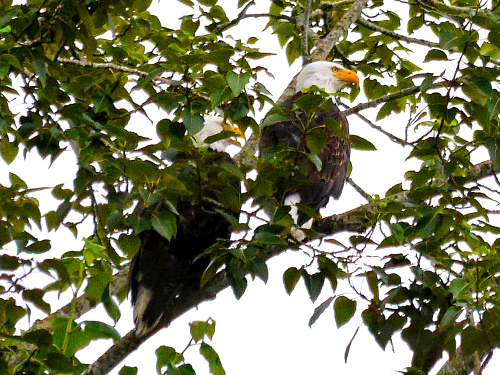 Adult Bald Eagles after having eaten the fish they stole from an Osprey. Photo by Ollie Oliver |
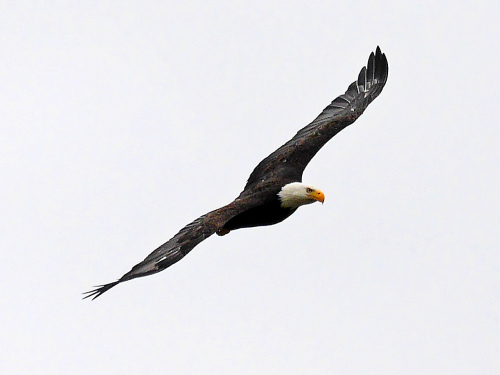 30 minutes later, a Bald Eagle approaches the Compost Piles. Photo by Ollie Oliver |
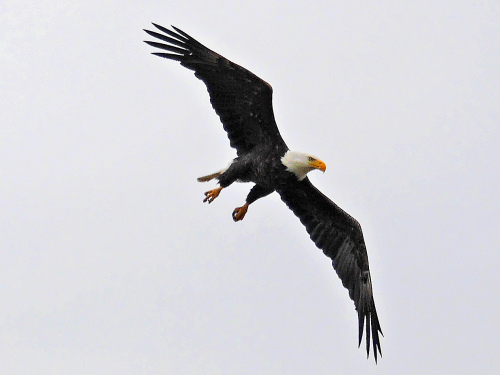 The Bald Eagle lowers its talons. Photo by Ollie Oliver |
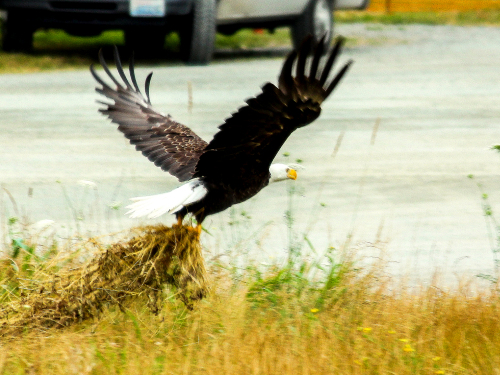 ...and grabs a pile of weeds. Photo by Lillian Reis |
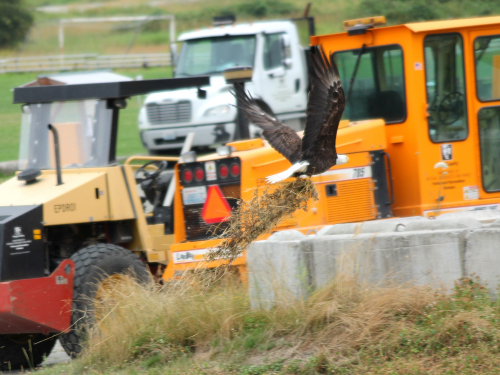 Photo by Lillian Reis |
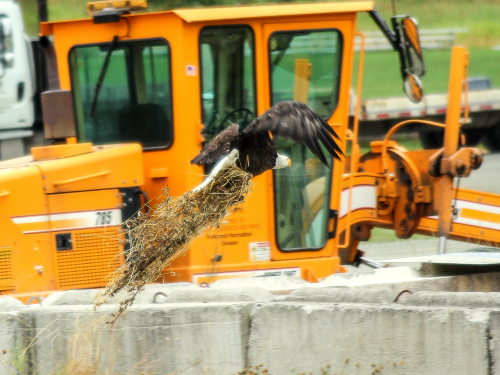 Photo by Lillian Reis |
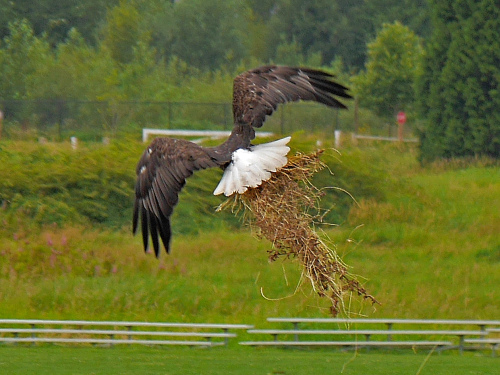 The weeds were apparently heavy and created a lot of drag. Photo by Ollie Oliver |
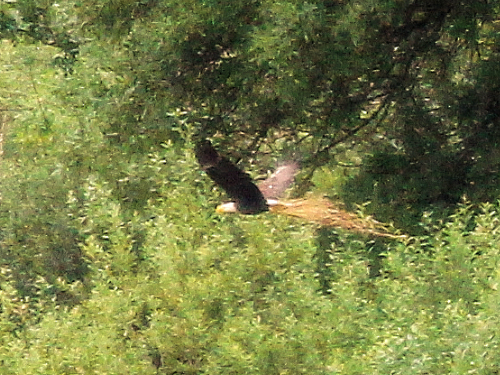 The eagle was unable to gain much altitude as it flew the length of the Dog Meadow. Photo by Lillian Reis |
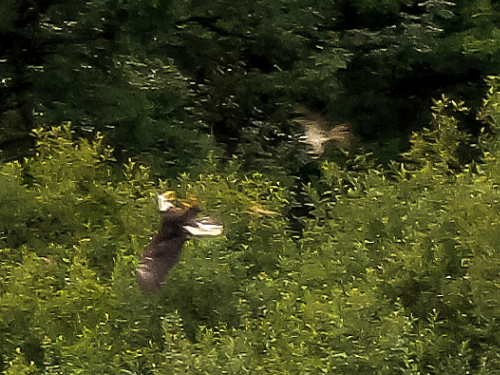 The Osprey, seeking payback, dives on the eagle, which jettisons the weeds (barely visible between the birds) and turns on its back to fend off the Osprey. Photo by Lillian Reis |
 The weeds drift towards the ground as the Osprey continues on towards the lake, leaving the Bald Eagle shaken. Photo by Lillian Reis |
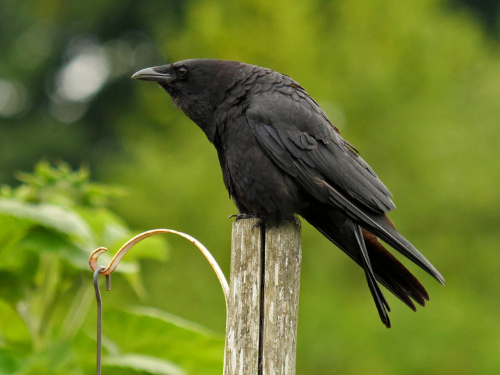 American Crow stretching. Photo by Ollie Oliver |
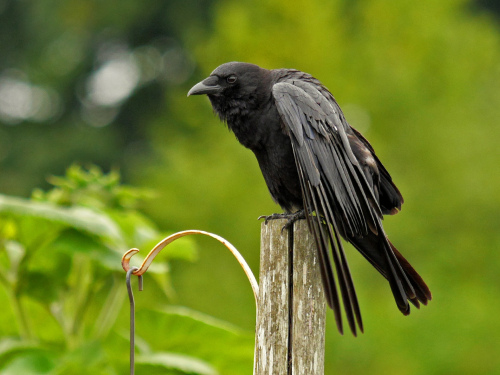 American Crow stretching. Photo by Ollie Oliver |
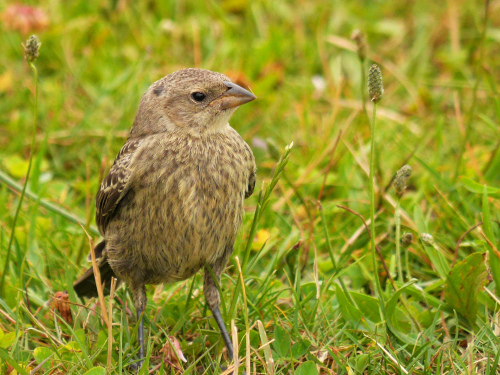 Juvenile Brown-headed Cowbird. Photo by Ollie Oliver |
 Brown Creeper. Photo by Ollie Oliver |
 Spotted Sandpiper at the weir, 2013-07-17. Photo by Dasha Gudalewicz |
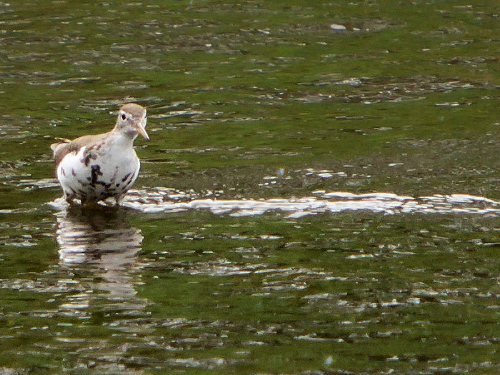 Spotted Sandpiper at the weir, 2013-07-17. Photo by Dasha Gudalewicz |
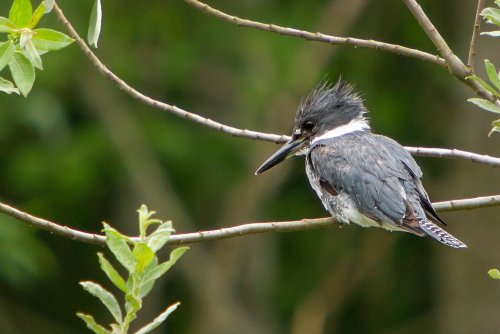 |
Belted Kingfisher at the weir, 2013-07-17. Photo by Dasha Gudalewicz |
Report for July 19, 2012 Birding at Marymoor
|
We had nice weather, but it was very quiet today at Marymoor. A few species were singing constantly: Willow Flycatcher, Western Wood-Pewee, Bewick's and Marsh Wrens, Swainson's Thrush, and Common Yellowthroat, but there wasn't a whole lot else. Even those species were not very easy to see. Still, we walked the loop slowly and carefully, and managed to find some birds. |
|
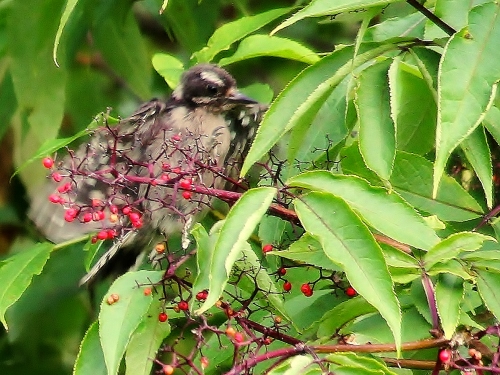 Juvenile Downy Woodpecker eating Red Elderberries. Photo by Lillian Reis |
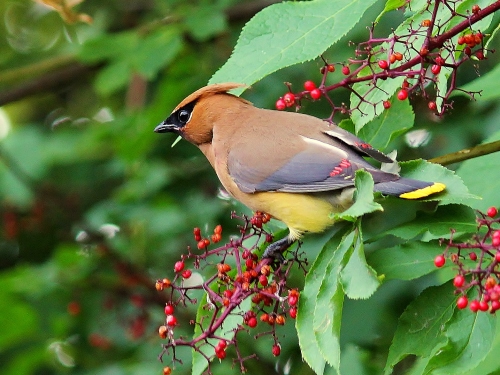 Cedar Waxwing eating Red Elderberries. Photo by Lillian Reis |
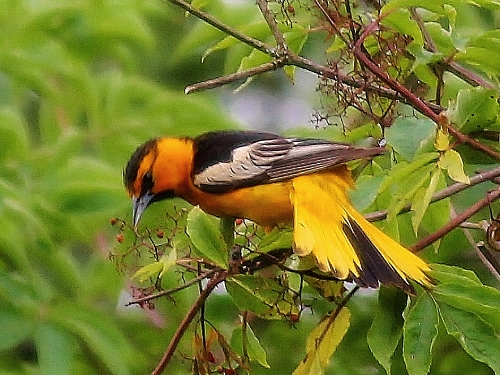 Male Bullock's Oriole eating Red Elderberries. Photo by Lillian Reis |
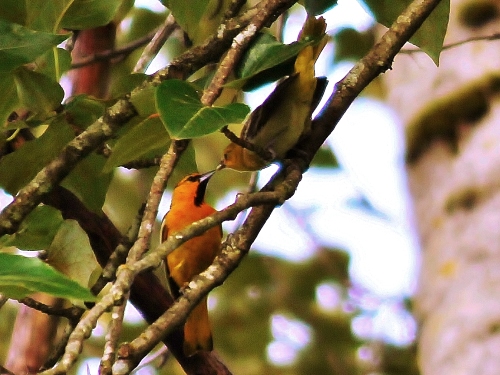 Male Bullock's Oriole feeding juvenile. Photo by Lillian Reis |
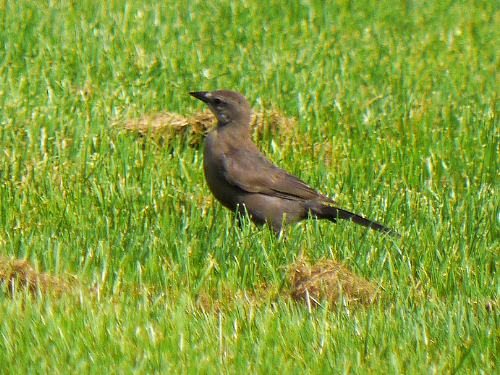 Female Brewer's Blackbird. Photo by Ollie Oliver |
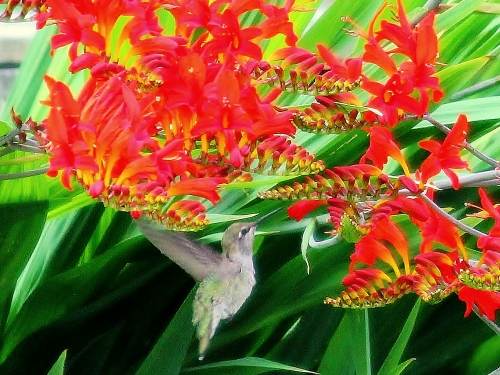 Anna's Hummingbird in the Pea Patch. Photo by Lillian Reis |
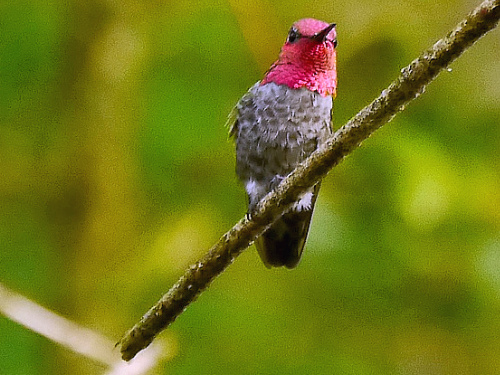 Male Anna's Hummingbird. Photo by Ollie Oliver |
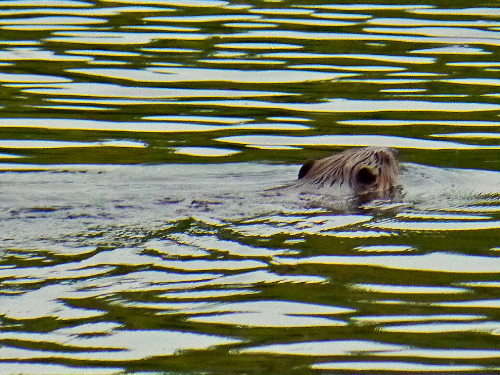 Beaver in the slough. Photo by Ollie Oliver |
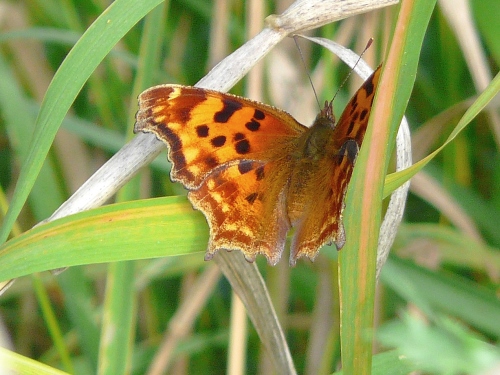 Satyr Comma butterfly. Photo by Hugh Jennings |
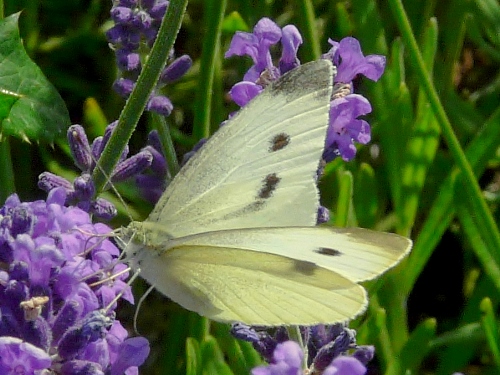 Cabbage White butterfly. Photo by Hugh Jennings |
Report for July 21, 2011 Birding at Marymoor
|
I usually try to start our walks soon after sunrise. I was pushing things a bit by starting this morning a few minutes before the 5:33 a.m. official sunrise. It didn't really matter. It was dark before sunrise. It was dark long after sunrise. Heavy overcast, quite a bit of mist, mizzle, drizzle, and a little bit of almost rain this morning. Birds were hard to see, and there wasn't much singing. There were lots of awkward-looking juveniles about, and quite a few fledglings begging for food. But by the end of the morning, we had the largest species count we've had since early June. Go figure. |
|
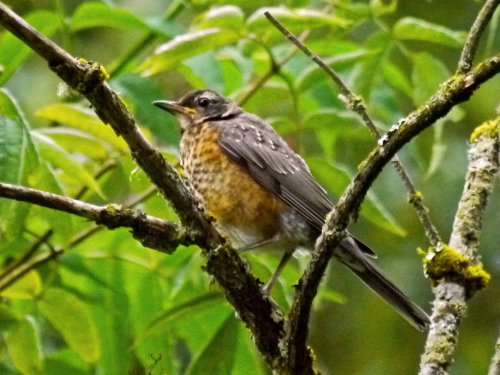 Juvenile American Robin. Photo by Ollie Oliver |
 Adult male Bullock's Oriole. Photo by Ollie Oliver |
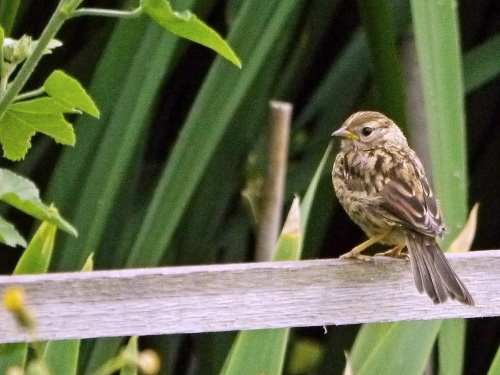 Juvenile White-crowned Sparrow (still in juvenal plumage). Photo by Ollie Oliver |
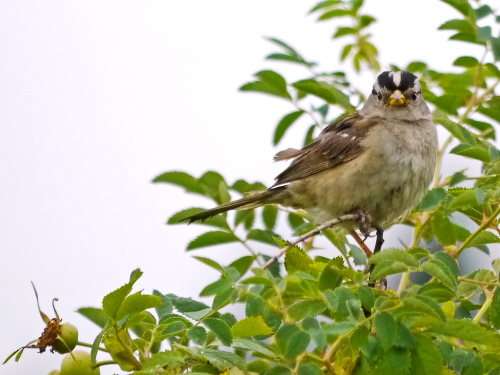 Adult White-crowned Sparrow. Photo by Ollie Oliver |
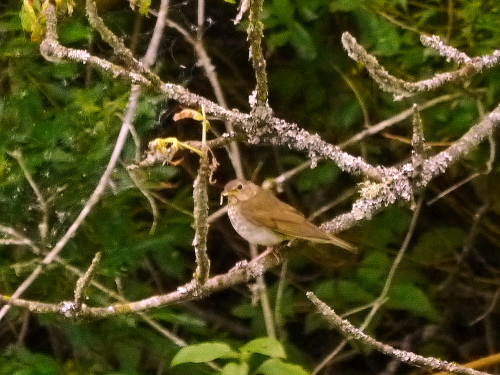 Swainson's Thrush. Photo by Ollie Oliver |
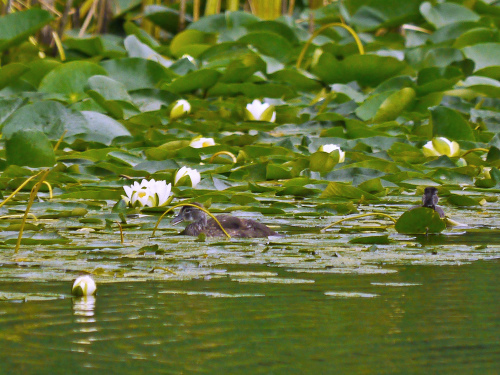 Juvenile Wood Ducks. Photo by Ollie Oliver |
Report for July 22, 2010
|
It was cold, with heavy overcast, breezy, and at times misty at Marymoor this morning. Add in the late-summer blahs, and it wasn't our most exciting day at the park.
For the day, 56 species were noted. It was a group effort (translation: several species were seen only by 1-2 people). |
|
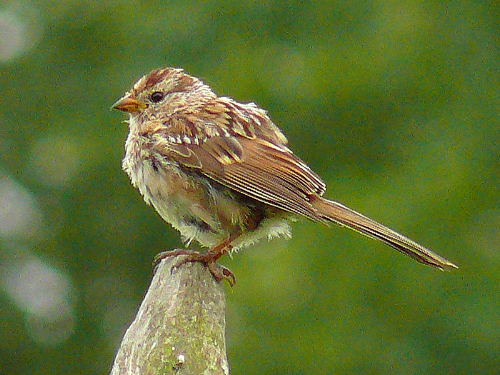 Juvenile White-crowned Sparrow. Photo by Ollie Oliver |
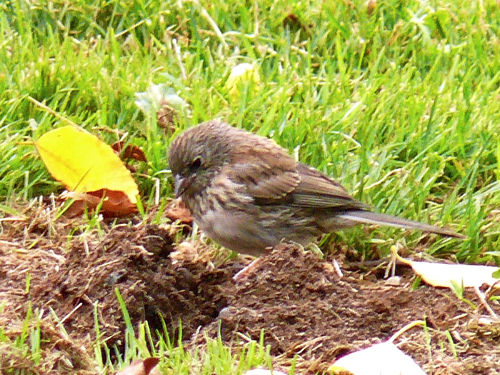 Juvenile Junco. Photo by Ollie Oliver |
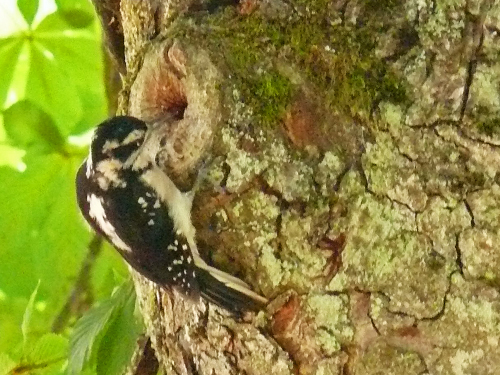 Hairy Woodpecker. Photo by Ollie Oliver |
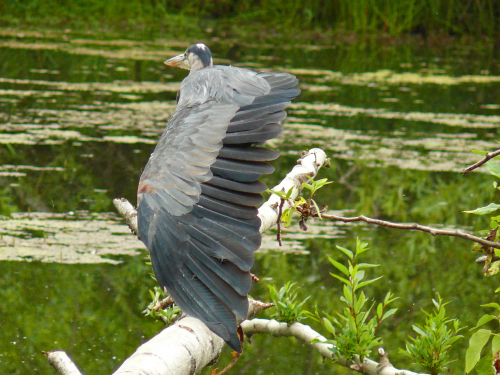 "Streeeeetch". Great Blue Heron. Photo by Ollie Oliver |
 |
Juvenile Cedar Waxwing. Photo by Lillian Reis, 2010-07-18 |
Report for July 16, 2009
|
It was a really nice summer day. Unfortunately, I had to leave after only 2 hours to take my son to the airport, so Brian Bell compiled the list for the day. Highlights: The male RING-NECKED PHEASANT was seen early on the grass fields, and heard later. We had one CALIFORNIA GULL fly down the slough at about 6:00 a.m. We had our first-ever July sighting of PILEATED WOODPECKER, calling and seen flying west of the park. Sharon Aagaard found a juvenile BARN OWL in the maple tree next to the nest box, straight above the path. The rest of us had given up on finding one. It appears that only a single baby was fledged this year from the nest box. BROWN CREEPER was heard singing; later, a family with adult and juveniles was seen. At least one LAZULI BUNTING was still singing near the Compost Piles. BULLOCK'S ORIOLE: Brian noted "2 or 3 males, female, several young being fed, including one without a tail" For the day, I think 56 species. == Michael |
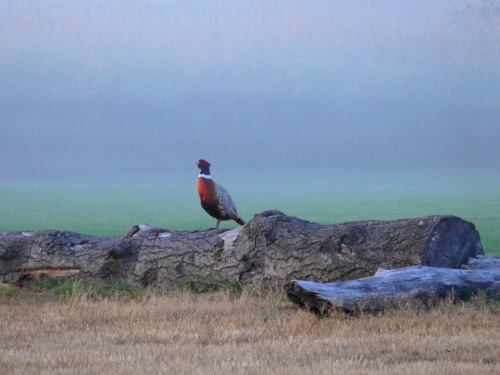 Male Ring-necked Pheasant in the early morning fog 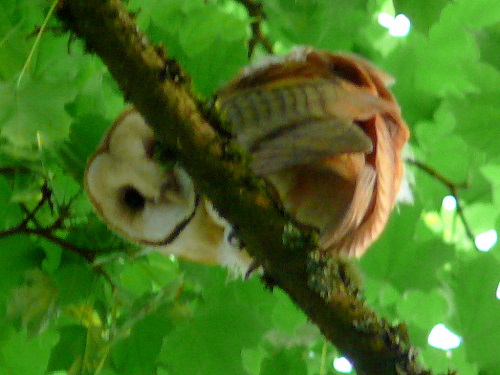 Juvenile Barn Owl in a maple tree near the nest box |
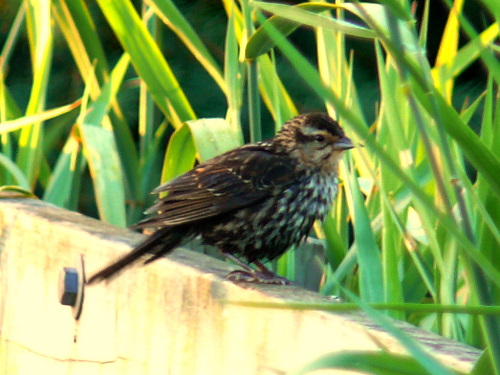 Juvenile Red-winged Blackbird |
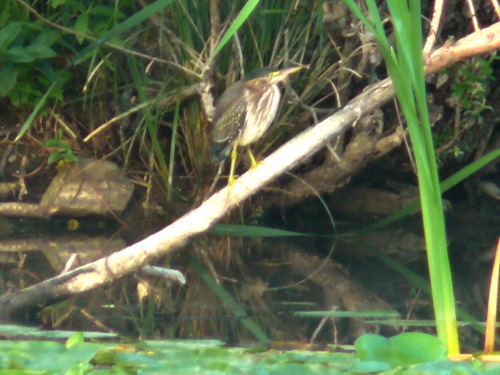 Juvenile Green Heron |
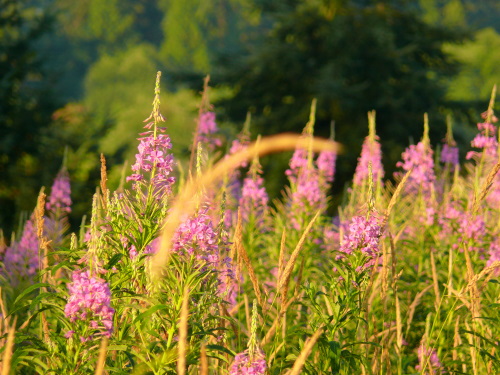 Fireweed |
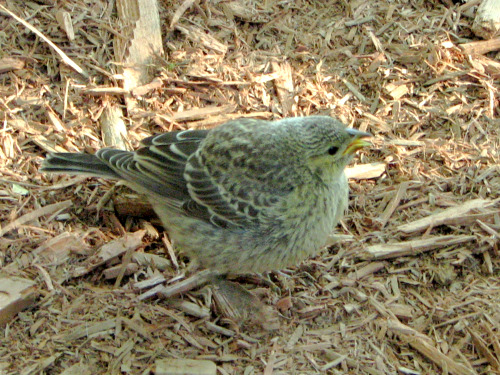 Juvenile Brown-headed Cowbird, photo by Scott Ramos |
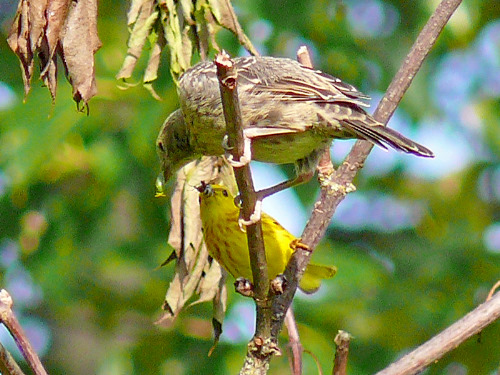 Male Yellow Warbler feeding juvenile Brown-headed Cowbird. Photo by Ollie Oliver, June 18 |
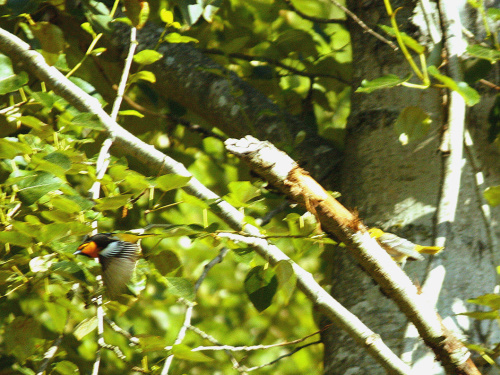 Bullock's Oriole pair. Photo by Lillian Reis, June 19. |
 Rufous Hummingbird - two views |
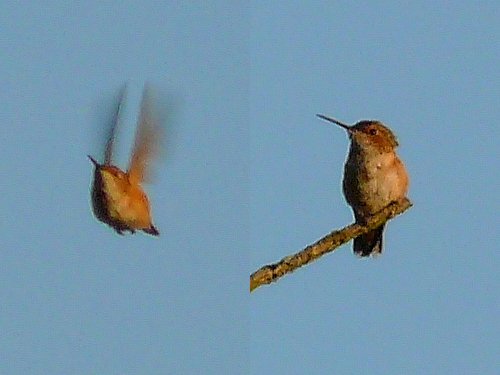 Rufous Hummingbird - two more views |
Report for July 17, 2008
|
It was chilly, a touch breezy, and more overcast than I was expecting this morning. We're in the doldrums - nothing unusual expected or found - but the park still has it's attractions. We had a really good day. The first highlight were three RIVER OTTERS actively fishing (or crawfishing perhaps) in the slough above the weir. They gave a great show. We had a STELLER'S JAY already going after the very green Hazelnuts One CASPIAN TERN was over the lake Nice looks at a RED-EYED VIREO north of the east end of the boardwalk And then there were the babies: Wood Duck 3 clutches of ducklings The COOPER'S HAWK nest lay on the ground under the tree it was in. The three babies were in the trees nearby, two together and a third a little apart. An adult was seen leaving the scene. The five fledged GREEN HERONS were at the main pond at the Rowing Club, flying (and especially landing) awkwardly. One was thinking about trying to fish, but was working from a branch too high above the water. The rest seemed willing to wait for Mom or Dad to deliver. An adult did arrive and was mobbed. == Michael |
|
|
|
|
|
|
|
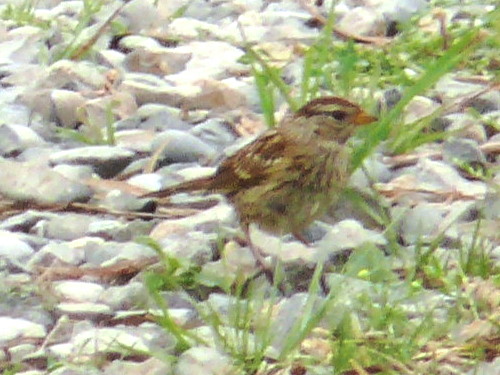 White-crowned Sparrow in juvenal plumage at the Compost Piles |
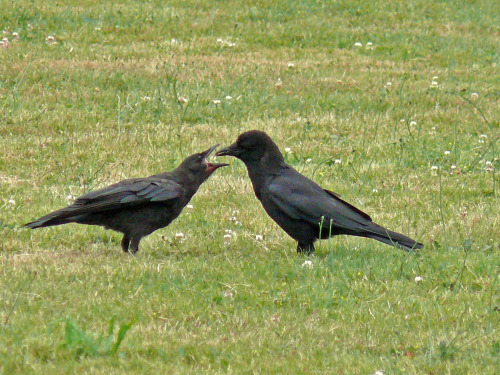 Ollie Oliver's photo of an adult American Crow feeding a youngster |
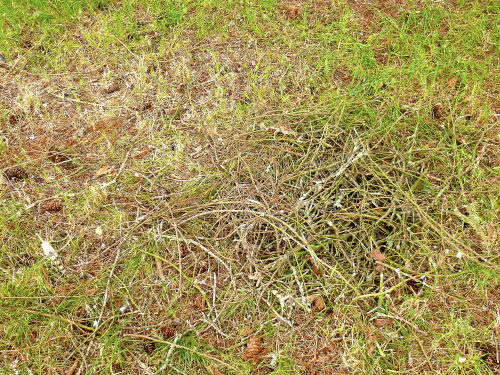 The remains of the Cooper's Hawk nest on the ground |
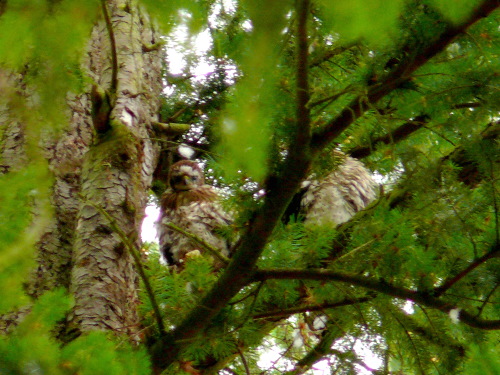 Two of the three young Cooper's Hawks northeast of the mansion |
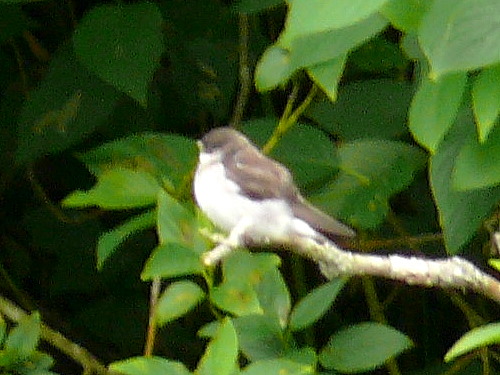 Juvenile Violet-green Swallow, later fed by an adult |
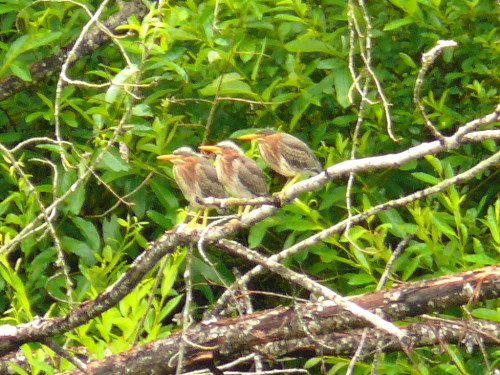 Three of the five fledged Green Herons at the Rowing Club |
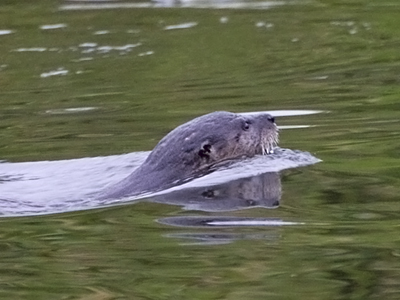 Sunny Walter's better shot of one of the otters |
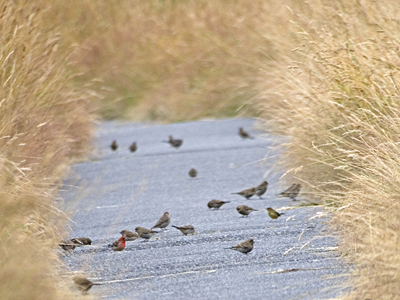 And Sunny caught a few of the multitude of House Finch on the path |
Report for July 19, 2007
|
Eight of us enjoyed a pleasant and interesting morning at Marymoor. As we move into the post-breeding period, a few new things are moving in/through. The weather was overcast, but clearing (no rain, no wind). Highlights: Green Heron Multiple sightings, at least 2 adults At about 5:45 a.m., to BELTED KINGFISHERS flew north over the South Lot. A third bird flying with them looked slightly different - pointed wings, a thinner bill, trailing legs - Just as I got on it, it gave the tew-tew-tew call of a GREATER YELLOWLEGS. In a weird deja vu moment, five hours later, as we came back through the South Lot, three birds flew north. This time, all three were kingfishers. Lots and lots of babies of just about everything. Trees dripping with young VIOLET-GREEN SWALLOWS. Ducklings (MALLARD, WOODIE, HOODIE), Goslings, wrens, finches, etc. Young warblers were a bit of a challenge to ID - certainly several COMMON YELLOWTHROATS, at least one YELLOW WARBLER, maybe a WILSON'S... Anyway, a good day. For the day, including the LEAST FLYCATCHER (see below), 61 species. The Mourning Dove and the Greater Yellowlegs were new for 2007. == Michael Today [2007-07-19] we couldn't do the early morning walk but we got out there later and did an abbreviated version of it. we found the LEAST FLYCATCHER calling at the compost mounds in a large willow (?) tree surrounded by blackberries. he was doing his "chebeck" call quite a bit so he should not be to hard to find. we last saw him at about 11:50. Brendan Higgins, Seattle WA |
|
|
|
|
|
|
Black-tailed Deer in slough just south of the main entrance bridge |
Prev |
Bird Sightings Week 29
|
Next |




